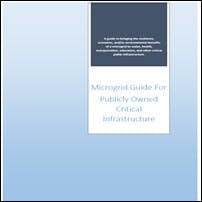Dissecting the Planning Phase of Public Infrastructure Microgrid Development
This guest post is adapted from a new white paper on microgrid development by the DOE’s Rima Kasia Oueid that outlines three development phases for public critical infrastructure microgrids. This entry explores Phase 2: planning.
Download the full report
The planning phase involves significant preparation work for the project that begins with broader stakeholder outreach to obtain policy, community, and operational input and to identify outside barriers to the microgrid. This phase also involves identifying key staff resources, regulatory considerations, tools, funding, potential revenue streams, potential project and ownership structures, and estimated capital, operations and maintenance costs.
Involve stakeholders in project preparation
As part of planning and project preparation in phase 2, the leadership team and working groups need to consult subject matter experts and other stakeholders when selecting and executing near-term actions. Many of these stakeholders may be affected by project implementation and will likely have participated in one of the earlier phases. The project preparation consultations with stakeholders should consider how to prioritize projects.
Identify project team and staff resources
The microgrid initiative could involve implementing one traditional microgrid or a network of advanced microgrids. Large state-led microgrid deployment efforts may require overhauling or clarifying certain policies, designing state or utility-led programs, establishing finance programs, assessing energy resources, conducting feasibility studies, updating the electricity grid, and developing a workforce. Meanwhile a single facility pursuing an onsite microgrid will want to know how to navigate state, local, and federal policies and programs, conduct feasibility studies, prepare their own workforce, and develop viable business models to justify the investment.
The leadership team and project team for intermediate and advanced microgrids may overlap, and the team size may vary, however, the following roles and responsibilities capture the critical buckets that team members will fall into:
- Project lead
- Champion(s)
- Subject matter expert(s)
- Project execution staff
Identify planning tools
In this section, the leadership and project teams will collaborate to identify tools that can be leveraged to implement the vision. Tools can range from available design engineering tools, to economic and policy or regulatory tools. The types of tools will vary depending on the level of detail of planning effort and scale of the microgrid initiative.
Design and engineering tools assist in the feasibility and design analysis.
Financial or economic tools will enable review and assessment of market access opportunities for revenue generation or savings.
Recognize ISO/RTO Requirements (Applies to Advanced Microgrids, May Apply to Intermediate Microgrids)
Much of the United States is covered by seven organized power markets. Each market is operated by a Regional Transmission Operator (RTO) or Independent System Operator (ISO) that operates the transmission system in its territory, operates markets for energy and ancillary services, and maintains system reliability. Each power market offers its own unique set of ancillary services, and precise definitions, requirements, and market mechanisms. ISO/RTOs procure electricity by matching supply with demand through a series of day-ahead and real-time market clearing processes. ISO/RTOs perform many of the same transmission functions as the vertically-integrated utilities that were supplanted by electricity restructuring.
Figure 12 provides a map of the current ISO/RTO markets:
Map of Transmission Operators that Serve the United States (Graph: U.S. Department of Energy)
In PJM, there are two models for microgrid participation — as an interconnected generator or as a demand response resource. ISO/RTO market operators each have their own interconnection process and requirements. The process flow chart below outlines the PJM Interconnection process — the timeline can be long and costly. Some ISO/RTO markets have minimum size requirements. Microgrids must have sufficient generation or demand response available to participate in wholesale markets. They must plan to have a percentage of their capacity available for market participation while retaining sufficient resources to serve their own critical loads. For large microgrid projects that plan to participate in ISO/RTO markets, it is recommended to meet with ISO/RTO staff to clarify requirements, expectations, and next steps.
PJM Interconnection Process Flow (Graph: PJM)
Understand PUC requirements and right-of-ways
The Public Utility Commission (PUC)—also known as a utilities commission, utility regulatory commission, or public service commission—is the governing body typically for a state that regulates the rates and services of a utility that maintains electric infrastructure for a public service. In deregulated states that includes electric distribution utilities; whereas in regulated states, the PUC could regulate the electric utility from generation to transmission and distribution, many of which are vertically integrated utilities that have monopolies.
Consider other FERC regulations (Applies to advanced microgrids; may apply to intermediate microgrids)
The Federal Energy Regulatory Commission (FERC) regulates the transmission and wholesale sale of electricity and natural gas in interstate commerce. Federal regulatory rules should be considered for certain microgrid applications. For example, PURPA is the Public Utilities Regulatory Policy Act of 1978. PURPA requires electric utilities, when they need power, to purchase power from qualified facilities (QFs) at the utilities’ avoided cost (which is set by the PUC), provide back-up power to QFs, interconnect with QFs, and operate with QFs under reasonable terms and conditions. PURPA generally exempts QFs, such as small renewable power generation and certain cogeneration, from regulation under the Federal Power Act (FPA). Some microgrids may qualify as QFs and may be able to obtain PURPA contracts as a source of revenue.
Interconnection, network upgrades, and otther considerations
The interconnection process for non-utility owned microgrids are generally negotiated on a project-by-project basis and differ in each state. For example, in PJM defines an interconnection process in which the utility conducts an interconnection study, determines the cost of interconnection and any network upgrades that may be needed through a self-directed internal process, then negotiates the cost directly with the microgrid developer. The cost of the interconnection study (if required by the utility) are typically paid by the microgrid owner.
Revenue streams
When developing a microgrid, it is critical to consider the potential revenue streams that can be monetized. This will impact financing options, may affect the size of the system , and should be factored into the decision of whether or not to own the microgrid. If microgrid ownership is not an option, then it may be helpful to consider options to capture some of these benefits, such as through a third-party contract. The more secure a revenue stream is, then the better the financing terms or options that will be available. With the appropriate controls, certain locations and generation resources could enable microgrids to monetize a variety of potential revenue streams.
Develop funding and financing pathways
Microgrids require significant up-front capital which can be a deterrent for some customers who cannot afford the initial large investment. Data on specific sources of capital used to develop microgrids is not readily available, and there is limited microgrid performance data to inform potential investors. Generally, the greater the revenue certainty for a microgrid then the better the financing terms and options that will be available. Based on limited public data, it appears that most microgrids are funded by existing owner balance sheets. However, finance options could include innovative project finance models or public private partnerships that capitalize on bilateral contracts, tax credits, energy, capacity, demand response, and ancillary services. Financing or funding may also come from municipal, state, or federal programs. Therefore, funding and financing sources will vary depending on the project, the location, ownership, and certainty of revenue streams/or loan repayment.
Consider project structure and ownership models
Ownership options, including third party and utility ownership, should be discussed as part of the pre-conceptual design process or as early as the feasibility study where possible. Input from the regulatory authority (typically the state Public Utility Regulatory Commission) and the utility is useful to make an informed determination and avoid the risk of violating any utility franchise rights. Additional analysis on ownership will need to be made to determine monetization of potential value streams and the ability to capture the value of the federal clean energy tax credits.
Regulatory issues
Regulatory barriers and market rules can be a major hurdle to microgrid development for both private sector developers and utilities. Microgrid development has been for the most part limited to traditional project models where local intra-facility needs dictate project scope and scale, as opposed to consideration of benefits that go beyond the immediate load or cost-optimal capacity for continuous service. A primary obstacle to broader application is the lack of a mechanism for the market to compensate non-utility and utility microgrid owners for the added benefits provided by microgrids. Market incentives for investment in resilience, efficiency, lower emissions and diversification may require changes in some regulatory environments.
NEPA, environmental reviews, and permitting
Depending on project size and/or whether project funds exceed a certain amount, some states may have mandates or executive orders that require an environmental assessment or review such as an environmental impact statement (EIS). Projects that receive federal funds or require certain major federal actions or decisions may also be subject to the National Environmental Policy Act (NEPA) enacted in 1970.
Costs, operations and maintenance
The greatest costs involved in building a microgrid are the energy resources, including the controller, distributed generation resources, and storage. This could represent over 40% of the build cost. The more advanced microgrids will require more expensive controllers and additional infrastructure, and in some cases of large microgrids, upgrades to substations or feeder lines.
Develop Project Performance and Reporting Plans
With clarity on which microgrid project(s) will be pursued and the resources available for staff, funding, and finance, the team can begin outlining performance and reporting plans. Reporting plans may also include regular check-ins during the project to help prioritize tasks, assign the appropriate resources, make connections where needed, and address issues or barriers as soon as they are known. The team will also need to establish metrics to set expectations with contractors and vendors.
Read more in the coming weeks about microgrid development from a new DOE report that covers the following topics:
- Exploring the 1st Development Phase of Public Infrastructure Microgrids
- Walk Through the Last of the Microgrid Development Phases: Implementation
This guest post was written by the DOE’s Rima Kasia Oueid. She is a senior policy adviser at the U.S. Department of Energy. This article is an excerpt adapted from her report, “Microgrid Guide for Publicly Owned Critical Infrastructure,” available for free download.

